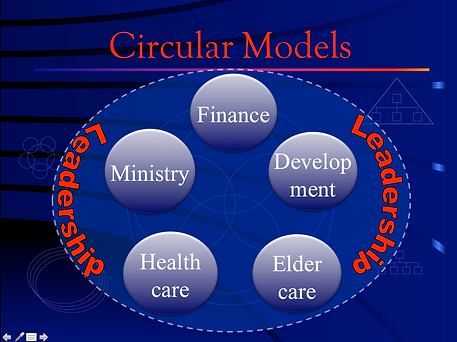
New
Models
What do we mean by new models?
New models of governance are being developed regularly by communities who have found existing models wanting. Many of the traditional “hierarchical” models, for example, fail to respond to the desired kinds of “partnerships” between leaders and members. “Mutual accountability,” “co-responsibility” and “subsidiarity” are examples of values expressed by contemporary communities, but fail to be represented by traditional models. Too often leadership is experienced as pushing and prodding the members along, while members resist. We/they camps emerge as leaders and members push and pull in different directions. Leadership gets blamed for the problems and become defensive or over-functions in response.
In 2006, Dr. Ted Dunn published an article that outlines various new models of leadership and approaches to governance: “Circular models of leadership: Birthing a new way of being.” (see Circular Models in published articles). In it he describes a variety of ways in which communities are organizing in order to meet contemporary demands and represent contemporary values.
What communities are realizing is that they desire a stronger “partnership’ between leaders and members, not a we/they opposition. Ira Chaleff recently wrote a book entitled, “Courageous Followers: Standing up for our leaders.” He and many others are finding a way to express a mutual partnership between leaders and members. This is a great reframe to understand the dynamic of leaders and members as something other than competitive.
What are Circular Models of Leadership?
In 2006, Dr. Ted Dunn published an article that outlines various new models of leadership and approaches to governance: “Circular models of leadership: Birthing a new way of being” (see and Published Articles). In it he describes a variety of ways in which communities are organizing in order to meet contemporary demands and represent contemporary values. He describes and draws the distinction between Hierarchical Models, Concentric Models and Circular Models of Leadership…
“Many religious communities are exploring new models of leadership in light of current realities, future trends and a fundamental shift in values. In the face of diminishing numbers and advancing age, for instance, many are wondering if the traditional models are best suited for them. Communities embracing new values, such as “co-responsibility” and “mutual accountability” experience that existing hierarchical models of governance are woefully inadequate. They wish to create more circular models of leadership that promote greater ownership and partnership in their community’s life and mission.
Traditional hierarchical models of leadership are inbred both in our society and in our psyche. Nearly every organization in which we live and work, governments, businesses, militaries and churches alike, are set up in a hierarchical fashion. A leader sits at the top who delegates authority and responsibility to the next level of management, who in turn delegates in a similar manner to those below them. We are all accustomed to this top-down, command and control world order.
However, some religious communities have been quietly breaking the mold and branching out into new models of leadership. “Teams” have replaced councils, “leadership” has replaced administration and, in some cases, there is no one person who sits at the top. Instead, the traditional responsibilities of leadership have been distributed to a wider circle of members who choose to share the burden, power and privilege of leadership in a more egalitarian manner. New circular structures and concomitant values of mutuality, shared ownership and co-responsibility are challenging the old top-down paradigm.
While these movements are taking place there is a relative dearth of written material that can help guide communities seeking to create such models. This article is an effort to share the experience of communities that have begun the transformative journey of creating new models and birthing a new way of being. We will explore what is compelling these communities to change, some guiding principles for embarking on such change and departure points for creating new models…”

